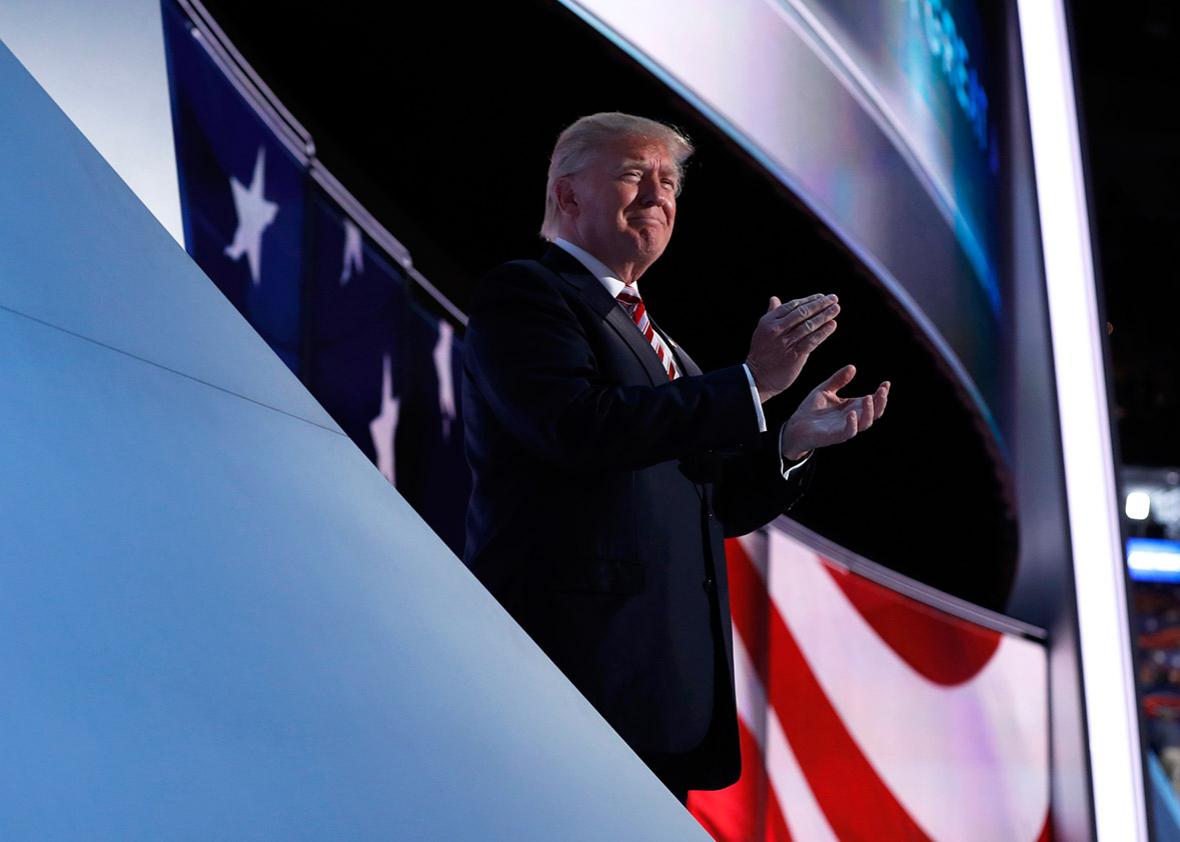Donald Trump is scared. And why wouldn’t he be? America, as he described it in his Republican National Convention speech on Thursday night, is being attacked from all sides: not only by terrorists and illegal immigrants coming into the country from the outside but also by violent criminals born and raised right here at home. These criminals are stalking our streets and killing at unprecedented rates. It’s a scary situation, and anyone who doesn’t see it that way is a fool.
Trump painted his Hieronymus Bosch–like portrait of the country by reciting a litany of grim crime statistics. Homicides in America’s 50 biggest cities shot up by 17 percent from 2014 to 2015, he said, while in Washington, D.C., and Baltimore, they have gone up by 50 and 60 percent, respectively. In Chicago, Trump said, there have been more than 2,000 shooting victims this year so far.
It’s tempting to dismiss Trump’s speech as fearmongering, which it undoubtedly is. The Republican nominee needs to stoke fear in voters so that they’re more likely to fall into the arms of the “law and order candidate”—someone who will come into office and make all “the crime and violence that today afflicts our nation” instantly “come to an end.” It’s an old tactic, and one that takes advantage of the persistently widespread belief among Americans that crime is a serious problem that’s only getting worse.
The truth, as many liberal commentators reminded their readers on Thursday after Trump’s speech leaked online, is that violent crime has been in a steady, long-term decline since 1991. As Drake Baer noted in New York magazine recently, the Reagan era saw an average of about 20,000 murders a year in the U.S.; in 2014, the most recent year for which FBI data is available, that number was under 15,000, even though the population had increased by about 80 million people.
These encouraging numbers are accurate. But here’s the problem: So are some of the troubling ones that Trump rattled off during his speech. Homicide did go up sharply last year in the nation’s 50 biggest cities. It went up by 63 percent in Baltimore and by 54.3 percent in Washington D.C. In Chicago so far this year, there have already been 2,224 shootings. These numbers are good fodder for fearmongering because they are legitimately scary. It should be possible to acknowledge them as reality while rejecting Trump’s craven and hollow attempt to leverage them for his own purposes.
As Lois Beckett reported recently in the Guardian, even Richard Rosenfeld, the criminologist whose research was once used to debunk the idea of a new violent crime wave, has come around to the idea that something significant is taking place. “These aren’t flukes or blips, this is a real increase,” the University of Missouri–St Louis professor told Beckett, in reference to the murder spike he observed in many big cities around the country. “We need to figure out why it happened.”
It’s important to keep last year’s numbers in perspective and to remain conscious of the fact that life throughout most of the country is safer than it’s ever been. But taking comfort in the big picture should not lead those of us who have never been personally affected by violent crime to deny the daily horrors and fears that many Americans, especially blacks and Latinos living in poor urban neighborhoods, must deal with on a daily basis.
The Donald Trump who spoke of “young Americans in Baltimore, in Chicago, in Detroit, in Ferguson” on Thursday might like those people to think he is their candidate: a leader who understands the danger they live in and knows how to protect them. But as his speech made almost obscenely obvious, Trump is not a man with any coherent ideas about what causes violent crime or how it might be stopped. The closest he came to diagnosing the problem was when he made a puzzling reference to the “administration’s rollback of criminal enforcement,” and the closest he came to offering a solution was promising to “appoint the best and brightest prosecutors and law enforcement officials in the country.”
As Trump may or may not know, the president has no role in appointing the vast majority of the country’s prosecutors and law enforcement officials. While there’s no doubt that the White House has a role to play in setting the broad contours of criminal justice policy, the work of making neighborhoods safer falls to state and local actors. If Trump were even a little bit serious about wanting to help do that work, he would not have used his RNC speech as an occasion to emit terrifying if vague noises while offering no real thoughts on how the glorious crime decline of the past 25 years has been achieved and what might be done to continue that trend instead of allowing it to end.
Still, if you’re an educated liberal settled in a safe, friendly place where no one dies of gunshots and no one fears for their life when they go outside, the desire to punish Trump for his tactics by proving his statistics wrong must be accompanied by a willingness to admit that the amount of violent crime some Americans deal with remains unacceptable and is becoming more so. To do so is not an exercise in fearmongering, but empathy.
